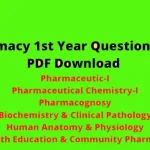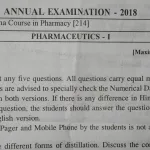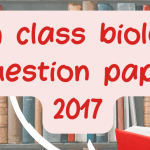B Pharm previous year question papers are crucial for students to understand exam patterns, important topics, and question types. This helps students prepare effectively for exams. Below is a compilation of questions and answers for various subjects under the B Pharm syllabus, categorized for easy understanding and effective revision.
Pharmaceutical Chemistry
Question: What is the difference between organic and inorganic chemistry?
Answer: Organic chemistry deals with carbon-containing compounds, while inorganic chemistry focuses on compounds that do not contain carbon.
Question: Define isomerism in organic chemistry.
Answer: Isomerism refers to compounds with the same molecular formula but different structural arrangements.
Question: Explain the mechanism of electrophilic substitution reactions.
Answer: In electrophilic substitution, an electrophile replaces a functional group, often facilitated by catalysts like acids.
Question: What is a Grignard reagent?
Answer: Grignard reagents are organomagnesium compounds used to form carbon-carbon bonds.
Question: Describe the process of esterification.
Answer: Esterification is the reaction between an alcohol and an acid to form an ester and water.
Question: What are aromatic hydrocarbons?
Answer: Aromatic hydrocarbons are compounds containing benzene or related ring structures.
Question: What is a nucleophile?
Answer: A nucleophile is a chemical species that donates an electron pair to form a chemical bond.
Question: How do acids and bases differ in the Brønsted-Lowry theory?
Answer: Acids donate protons, while bases accept protons in this theory.
Question: Define the term buffer solution.
Answer: Buffer solutions resist changes in pH when small amounts of acids or bases are added.
Question: What are amino acids?
Answer: Amino acids are organic compounds containing both amino (-NH2) and carboxyl (-COOH) groups.
Question: What are antibiotics?
Answer: Antibiotics are chemical substances that inhibit or kill bacterial growth.
Question: Explain the term “prodrug.”
Answer: A prodrug is an inactive compound that metabolizes into an active drug in the body.
Question: What is the role of enzymes in drug action?
Answer: Enzymes catalyze reactions that help drugs reach their site of action or metabolize.
Question: Describe the synthesis of aspirin.
Answer: Aspirin is synthesized by esterification of salicylic acid with acetic anhydride.
Question: What is a stereoisomer?
Answer: Stereoisomers are compounds with the same molecular formula but differ in spatial arrangement of atoms.
Question: Define chirality in chemistry.
Answer: Chirality refers to molecules that cannot be superimposed on their mirror image.
Question: What are alkaloids?
Answer: Alkaloids are naturally occurring organic compounds with pharmacological effects.
Question: What is the function of a chelating agent?
Answer: Chelating agents bind to metal ions, forming stable complexes and removing metals from solutions.
Question: Explain the concept of hydrogen bonding.
Answer: Hydrogen bonding is an attractive force between hydrogen and electronegative atoms like oxygen or nitrogen.
Question: What is polymerization?
Answer: Polymerization is the process of forming polymers by bonding monomers together.
Pharmaceutics
Question: What is the purpose of pharmaceutical excipients?
Answer: Excipients are inactive substances that stabilize or enhance the drug formulation.
Question: What is bioavailability?
Answer: Bioavailability is the proportion of a drug that enters circulation and produces an active effect.
Question: Define sustained-release dosage forms.
Answer: These dosage forms release drugs gradually over a prolonged period.
Question: What is the difference between a solution and a suspension?
Answer: Solutions are homogeneous mixtures, while suspensions are heterogeneous mixtures with visible particles.
Question: What are aerosols?
Answer: Aerosols are pressurized dosage forms that release medication as a fine spray.
Question: What is the purpose of granulation in tablet manufacturing?
Answer: Granulation improves flow properties and compressibility of powder for tablet production.
Question: Define dissolution rate.
Answer: Dissolution rate is the speed at which a drug dissolves in a solvent.
Question: What is lyophilization?
Answer: Lyophilization is a freeze-drying process used to preserve sensitive drugs.
Question: What are emulsions?
Answer: Emulsions are mixtures of two immiscible liquids stabilized by an emulsifying agent.
Question: Define the term “therapeutic window.”
Answer: Therapeutic window is the drug concentration range that is effective without being toxic.
Question: What is a parenteral route of drug administration?
Answer: It involves injecting drugs directly into the body bypassing the digestive system.
Question: What are micromeritics?
Answer: Micromeritics is the study of particle size and its distribution in powders.
Question: Explain the concept of osmosis in drug delivery.
Answer: Osmosis is the movement of solvent molecules through a semipermeable membrane from low to high solute concentration.
Question: What is a transdermal drug delivery system?
Answer: It delivers drugs through the skin for systemic effects.
Question: What is the difference between ointments and creams?
Answer: Ointments are oil-based, while creams are water-based emulsions.
Question: Define pharmacokinetics.
Answer: Pharmacokinetics is the study of drug absorption, distribution, metabolism, and excretion.
Question: What are suppositories?
Answer: Suppositories are solid dosage forms inserted into body cavities for drug release.
Question: Explain the function of disintegrants in tablets.
Answer: Disintegrants help tablets break down into smaller particles for faster drug release.
Question: What is the role of surfactants in pharmaceuticals?
Answer: Surfactants reduce surface tension to improve drug solubility and stability.
Question: What is the purpose of coating tablets?
Answer: Coating protects the tablet, improves taste, and controls drug release.
Pharmacology
Question: What is the difference between agonists and antagonists?
Answer: Agonists activate receptors, while antagonists block receptor activation.
Question: Define pharmacodynamics.
Answer: Pharmacodynamics is the study of the effects of drugs on the body.
Question: What are adverse drug reactions?
Answer: Adverse drug reactions are harmful or unintended effects of a drug.
Question: What is the role of neurotransmitters?
Answer: Neurotransmitters transmit signals between nerve cells.
Question: What is the function of beta-blockers?
Answer: Beta-blockers reduce heart rate and blood pressure by blocking beta-adrenergic receptors.
Question: Define therapeutic index.
Answer: Therapeutic index is the ratio of a drug’s toxic dose to its effective dose.
Question: What is drug tolerance?
Answer: Drug tolerance is reduced response to a drug over time.
Question: Explain the term “synergism” in pharmacology.
Answer: Synergism occurs when two drugs produce a greater effect together than individually.
Question: What are antihistamines?
Answer: Antihistamines block histamine receptors to reduce allergic reactions.
Question: What is a prodrug?
Answer: A prodrug is inactive until metabolized into an active form in the body.
Question: Define half-life in pharmacology.
Answer: Half-life is the time taken for a drug’s concentration to reduce by half in the body.
Question: What is the difference between local and systemic effects?
Answer: Local effects occur at the site of application, while systemic effects occur throughout the body.
Question: What are the side effects of opioids?
Answer: Side effects include drowsiness, constipation, nausea, and respiratory depression.
Question: Define the term “bioequivalence.”
Answer: Bioequivalence means two drugs have the same bioavailability and therapeutic effect.
Question: What is the mechanism of action of NSAIDs?
Answer: NSAIDs inhibit cyclooxygenase enzymes, reducing pain and inflammation.
Question: Explain the concept of receptor desensitization.
Answer: Receptor desensitization is the reduction in receptor response due to prolonged stimulation.
Question: What are diuretics?
Answer: Diuretics increase urine output by acting on the kidneys.
Question: What is the difference between bactericidal and bacteriostatic antibiotics?
Answer: Bactericidal antibiotics kill bacteria, while bacteriostatic antibiotics inhibit bacterial growth.
Question: What is the role of antacids?
Answer: Antacids neutralize stomach acid to relieve heartburn and indigestion.
Pharmacognosy
Question: What is pharmacognosy?
Answer: Pharmacognosy is the study of natural drugs derived from plants, animals, and minerals.
Question: What are glycosides?
Answer: Glycosides are compounds that yield sugars and other substances upon hydrolysis.
Question: Define the term “volatile oils.”
Answer: Volatile oils are aromatic compounds extracted from plants.
Question: What is the difference between tannins and alkaloids?
Answer: Tannins are polyphenols with astringent properties, while alkaloids are nitrogenous compounds with pharmacological effects.
Question: Explain the term “crude drug.”
Answer: Crude drugs are unprocessed natural substances used in medicine.
Question: What are saponins?
Answer: Saponins are natural compounds that produce a soap-like foam when mixed with water.
Question: Define resin in pharmacognosy.
Answer: Resins are complex mixtures of plant secretions insoluble in water.
Question: What are fixed oils?
Answer: Fixed oils are non-volatile oils derived from plants or animals.
Question: Explain the term “herbal medicine.”
Answer: Herbal medicine involves using plant-derived substances for therapeutic purposes.
Question: What are flavonoids?
Answer: Flavonoids are plant metabolites with antioxidant and anti-inflammatory properties.
Question: What is the difference between extract and tincture?
Answer: Extracts are concentrated forms of active constituents, while tinctures are solutions made using alcohol.
Question: Define adulteration in crude drugs.
Answer: Adulteration involves mixing or substituting inferior substances with crude drugs.
Question: What are terpenoids?
Answer: Terpenoids are naturally occurring organic compounds derived from isoprene units.
Question: What is the use of aloe vera in pharmacognosy?
Answer: Aloe vera is used for its soothing and wound-healing properties.
Question: What are plant alkaloids used for?
Answer: Alkaloids are used for various therapeutic purposes like pain relief and treating infections.
Question: What is the role of pharmacognosy in modern medicine?
Answer: Pharmacognosy aids in discovering new drugs and understanding natural remedies.
Question: What are anthraquinones?
Answer: Anthraquinones are compounds with laxative properties found in plants.
Question: Define essential oils.
Answer: Essential oils are concentrated plant extracts with aromatic and therapeutic properties.
Question: What are the sources of plant drugs?
Answer: Plant drugs are obtained from roots, leaves, flowers, seeds, and bark of plants.
B Pharm question papers provide a foundation for understanding key concepts, helping students excel in exams. Regular practice and comprehension of these questions improve problem-solving skills and confidence.
Latest Posts
- Step-by-step guide to download and apply for jee mains admit card 202
- Comprehensive 2025 government holidays and recruitment details for job seekers
- JEE Mains Admit Card 2025: Your Step-by-Step Guide to Downloading the Hall Ticket
- Everything You Need to Know About 2025 Government Holidays Recruitment
- Comprehensive Guide to rrb d group recruitment 2025 – Eligibility, Vacancies, and Application
- Detailed guide to nps trust recruitment 2025 vacancies, eligibility and apply process
- Comprehensive guide to hpcl recruitment 2025 notification, vacancies, and application process
- ignou bed admission 2025 complete recruitment guide with eligibility and process
- Comprehensive Guide to Indian Army Agniveer Recruitment 2025 Notification and Jobs
- Everything You Must Know About CBSE Board Exams 2025 Changes & New Rules






